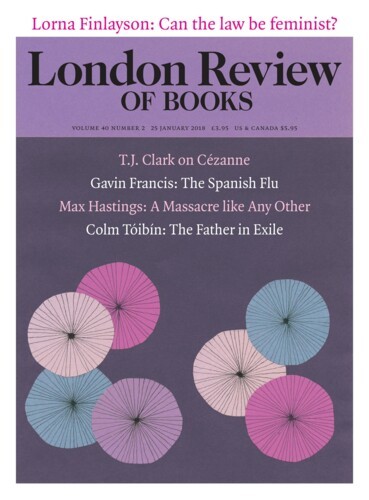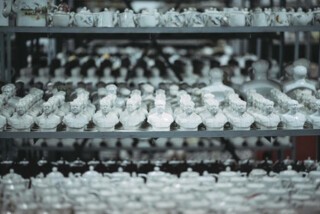In 2015 Fan Jianchuan was invited by the Chongqing government to open a new branch of his eponymous museum chain just outside the vast city. The original, the Jianchuan Museum Cluster in Anren, a small town of some 80,000 residents in south-west China, is the largest private museum in the country: it contains eight million items spread across 29 separate museum buildings covering 82 acres, complete with boating lake, hotel, restaurants and souvenir shops, a theatre and a field where visitors can camp. It is also the only museum in China to confront the history of the Cultural Revolution.
In Chongqing Fan has constructed eight museum buildings in ammunition factories built into the mountainside during the Second World War. The museum will have a particular focus on the city’s role during the war: it was Chiang Kai-shek’s provisional capital and was bombed by the Japanese. It will also tell the story of the site itself, and display some artefacts recovered from the factories, as well as other pieces from Fan’s collection. The complex is due to open next month: it was ready in October, when I visited, but the local government, which is building a street of hotels, restaurants, tea houses and shops, hadn’t kept up with the pace.
In Anren, a 40 ton Japanese bunker from Tianjin, rebuilt brick by brick in the mid-2000s, sits in the entrance to the museum. The site also features a vast array of decommissioned heavy weaponry that Fan sources through contacts in the army (in his late teens he was an artilleryman in Inner Mongolia). There are tanks, anti-aircraft guns, jet fighters, a battleship that leans lackadaisically in a giant stone mooring and an inter-continental ballistic missile, complete with launch pad. Before you reach the Japanese bunker, you walk under a giant scaffold bearing the aims of the museums: ‘to collect folklore for the sake of heritage; to collect lessons for the sake of the future; to collect war for the sake of peace; to collect disaster for the sake of tranquility.’ Each of these phrases represents one of the four strands of Fan’s collection: the Folk Culture Series, the Red Times Series (the name ‘Red Times’ is euphemistic: before the government intervened it was called the Cultural Revolution Series), the War of Resistance Series – the War of Resistance is the Chinese term for the Second World War – and the Earthquake Series.
State museums in China tend to avoid mention of the years from 1966 to 1976. In the National Museum of China in Tiananmen Square, the period is represented by a single photo of Red Guards waving to Mao in the square. In the Memorial Hall at Shaoshan, Mao’s birthplace, the Cultural Revolution and the Great Leap Forward go entirely unmentioned: the focus is on science and diplomacy. The 50th anniversary of the Cultural Revolution in 2016 went almost unmarked; the government’s only official acknowledgment of it came on the following day, 17 May, when identical editorials in the party mouthpieces the People’s Daily and the Global Times ran under the headline ‘50th Anniversary – Remembrance Should Not Be Extreme’.
Fan was a small child during the Cultural Revolution. At the age of nine he followed his father into rural exile. His father, a loyal communist, was believed to have capitalist tendencies and was ‘struggled’ against – the revolutionary term for being publicly denounced and beaten. At one struggle session, Fan’s father called to him from the dock and asked him to collect anything that might exonerate him. Fan started collecting newspapers, documents, anything he could find and particularly anything to do with his father. Is his autobiography, Slave to the Big Museum, he writes that he did so not just to clear his father’s name, but also to understand what was happening around him.
Fan didn’t set out to build a museum. Rather he began to collect more and more, first artefacts from the Cultural Revolution more generally, and then anything that seemed relevant to the wider sweep of the last hundred years of Chinese history. His time in the army, and that of his father, sparked an interest in objects to do with the military and China’s long-drawn-out ‘war of resistance’ against the Japanese. After leaving the army, Fan became the deputy mayor of Yibin, the second largest city in Sichuan, and amassed a fortune estimated at around $300 million. As his wealth increased, so did his collection. ‘I started with newspapers and documents. Now, I have over a hundred tons of them,’ he told me. Much of his collection, spread across vast warehouses the size of aircraft hangars, is measured by weight.
‘One thing helped my collecting more than anything,’ he told me, ‘the great movement of the Chinese people since the economy opened up.’ He estimates that since the early 1980s he has moved house more than twenty times. This isn’t unusual: as people’s fortunes have changed all over China they too have moved house and discarded unwanted possessions. Fan has been collecting their detritus. ‘A single letter is not history. But I have tens of thousands of letters, from every decade – from the 1960s, 1970s, 1980s, 1990s, all the way to today.’ Collecting, particularly in the 1980s and 1990s, wasn’t straightforward. At one stage, he had a fleet of small trucks driving around northern China: ‘A crazy guy from Sichuan wants your old mirrors,’ speakers on the back of the trucks boomed out. ‘He will give you ten yuan and replace your old mirror with a new one.’ Within a few months Fan had more than fifty thousand mirrors. The mirrors, all mid-century, are emblazoned with Mao’s face or phrases like ‘Never forget class struggle!’,’ Praise the red sun in the sky!’, ‘Remember that on the great sea you must rely on the great helmsman!’
The things on display in the museums constitute a fraction of the overall collection; most of it is still in the warehouses in Anren. The one I visited was cavernous, the kind of space where it takes a few seconds for the lights at the far end of the room to go on after the switch is flicked. There were walls of newspapers; countless porcelain busts of Mao; thousands upon thousands of mirrors leaning against each other. There are more items related to the Cultural Revolution than to anything else. When I asked Fan if his collection was open to academics he told me: ‘Only to the Chinese Social Sciences Academy’ (which is government affiliated). ‘I have signed a memorandum with them agreeing access.’ To other researchers it remains emphatically closed. ‘Harvard has asked, name any great institution, Chinese or Western, they have all asked, and I have turned them all down.’
Fan treads a careful line with the government in Beijing. Proposed exhibitions about the Anti-Rightist campaign or the Great Leap Forward have been rejected. In the case of the Cultural Revolution artefacts that aren’t on show, his concern isn’t so much the state’s reaction as the effect they might have on ordinary people. ‘My museum is dedicated to contemporary history,’ he says, ‘but in some cases these things are contemporary and not yet history. I have items that can implicate many people. Those who struggled. Those who were struggled against. In these records, I have damning things … I am probably the person alive today who has seen the most material from the Cultural Revolution. Do you know what this could do to people?’
In 1980 there were 407 museums in China; in 2014 alone 345 new museums opened. As of 2015 China had 4150 registered museums. ‘People told me I was crazy to do this,’ Fan said, ‘but I knew that as the economy grew, as we could eat our fill and have a roof over our heads, that the next thing we would desire was culture.’ Throughout his museums are signs featuring a more youthful Fan, fist held high, next to the words: ‘I can build you a museum in the fastest time!’ His construction company has been commissioned by cities around the country, places like Lijiang and Xichang, to build museums and culture parks. Unlike Chongqing, these projects don’t fly the Jianchuan flag, but Fan helps to select the location, source the items and build the museums.
Fan maintains that the most difficult thing about running a private museum, even one that brushes up against the edges of political acceptability, is ensuring its commercial survival. In Anren he has built a Cultural Revolution themed hotel and a people’s commune canteen, and sells T-shirts bearing Mao-era slogans. When I asked him if he found this a contradiction, on the one hand preserving the history of the Cultural Revolution and on the other commercialising it, he shook his head. ‘Only to you, because your opinion of museums – because you are Western – is too sacred. I don’t think of museums as sacred.’
Send Letters To:
The Editor
London Review of Books,
28 Little Russell Street
London, WC1A 2HN
letters@lrb.co.uk
Please include name, address, and a telephone number.


